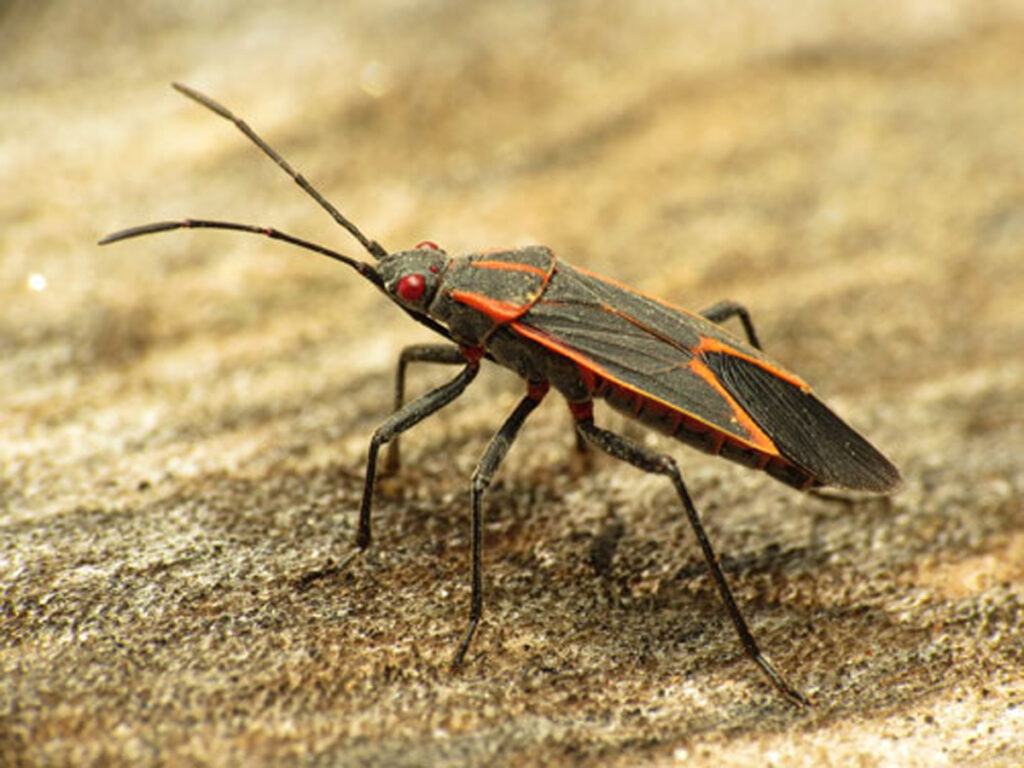Abra Kadabra Environmental Services is a connoisseur of bugs. It’s our job to know everything there is to know about every type of bug that can enter your home or office. The fact is, we love our job. We don’t necessarily love bugs, but we do find them to be quite fascinating. The fall is a great time of year to see some interesting, and relatively harmless bugs appear. One of the most interesting looking bugs we’ve have seen during fall-time is the Boxelder bug. This bug gets its name from the Boxelder tree, where the bugs are found feeding and laying eggs on.
All About Boxelder Bugs
I would not say that the boxelder bug is particularly beautiful. However, I would definitely say it is a distinctive looking bug with an unusual and remarkable design. The boxelder bug is black with reddish or orange lines down its back (or dorsum), making for a very cool, unique design. The stripes almost look like outlines of wings, with a Transformer mask type design in the center. These markings definitely make the boxelder bug appear much more menacing than it actually is.
The boxelder bug is not huge, but it is not tiny, either. It is about half an inch long and has six legs. Its shape is oblong and the head is quite flat, making it almost look like the common stink bug, with the exception of its unique markings. When found within a boxelder tree, the boxelder bugs look like a swarm of reddish or orange insects looking to attack.
Boxelder Bug’s Natural Habitat
The boxelder bug is found throughout the entire United States and the eastern part of Canada. It is mostly found where boxelder trees are widespread, such as in California and Nevada; however, they have been found in Minnesota, New England, and even several Canadian provinces as well. The boxelder bug likes to feed on the sap of maple and ash trees, and in particular, the boxelder tree. The key here is that the boxelder bug loves warmth. Therefore, in the summer, you will see it out and about, enjoying the sap of its home trees.
Nonetheless, our chief concern lies in where the boxelder bugs congregate in the fall and winter. These bugs are quite intelligent. Knowing the enjoyment they get from sunbathing, they tend to find warm spots to meet throughout the cooler autumn months. You will find them on rocks, huddled together on the side to get the most sunlight. You will also find them basking in the sun nearby trees or buildings. This is the last stage of trying to stay warm before they begin to hibernate for the winter. Yet, beware, because they will aim to hibernate in your home or office space next.
Boxelder Bugs Entering Your Home
As the days get shorter and the nights become cooler, boxelder bugs begin looking for a warm home. Your home, cabin or office is the perfect resting place for the boxelder bug to wait out the cold winter months. The truth is, they are virtually harmless, but they do cause some damage. Plus, you will now have to face an infestation in your home.
You may wonder how they even get inside your home. They are smart insects, and know how to look for any openings and infiltrate in the least obvious of places. You may never have noticed that small hole in your living room window caulking. Or, maybe there is a pin sized hole in your foundation. A small crack in any part of the exterior of your home is like a giant welcome sign for these insects. Unlike large rodents, bugs do not need a large opening to make their way into your personal dwelling. Once one finds a way in, they invite their buddies to settle in and disperse throughout your home.
Boxelder Bug Damage
Boxelder bugs are among the least harmful insects to have in your home, though they can still cause unfortunate incidents to happen. Even seemingly small occurrences can lead to significant damage to your home.
Let’s start with the physical damage. Boxelder bugs emit an orange dye from their bodies when they’re feeling threatened, or when they become crushed. Therefore, as they begin to rest in your home, on your carpet, and on your clothing, they may leave a mark of residue behind. You will notice orange spots wherever they have been. Therefore, you may find some of your clothes are no longer able to be worn without a thorough washing or dry cleaning.
The orange dye may also permanently stain your clothes, if it goes unnoticed for long periods of time. This means you may have to throw out some of your favorite garments. You may also need professional cleaning services to remove any orange dye from your carpet. In the worst-case scenario, if left unnoticed for too long, you will need to replace your carpets entirely. Remember, this is mostly the result of fecal matter left behind when a boxelder bug is crushed or scared.
As far as physical damage is concerned, the boxelder bug does not bite. However, that does not mean he is completely harmless. Like the mosquito, the boxelder bug can sting, and leave a red, itchy mark on its victims. You may notice your pets and children becoming targets for these bugs, and they can have more sensitive reactions when stung.
Preventative Measures For Boxelder Bugs
Since boxelder bugs like to find the smallest crack in your home’s armor, your job is to remove any opportunity for entry. During the beginning of fall and ending of summer, carefully inspect the exterior of your home. Look for cracks in the foundation, and look for areas near the windows that are cracking or have tiny holes. Any unintentional opening is a temptation for the boxelder bug. Close all of these holes completely, by using caulk. Additionally, be sure to repair cracks in your home’s foundation and exterior siding. Remove temptation for the boxelder bugs. They will be searching for shelter, but that warm place does not need to be inside your home.
Another helpful tool to prevent an infestation is to install door sweeps. Most exterior doors have small gaps between the foundation and the bottom of the door. This may be due to the house settling. It may also be due to poor construction; however, that is not the norm. Whatever the reason behind the gap between your entry doors and foundation, you must find a solution to fix it.
One of the most cost-effective methods to repairing this problem is a door sweep. These can be purchased at any hardware store or even online, at places like Amazon, for under $20. They fit right onto the bottom of your exterior door and help “sweep” bugs out. In addition, they are just long enough to close the gap between your exterior door and the foundation of your home.
Removing Boxelder Bugs From Your Home
Of course, prevention is always the best method to warding off boxelder bugs from your home. However, sometimes we are not able to get every little crack and hole filled before the first bug enters our home. The next step involves the removal of the boxelder bugs from your home. The first piece of advice you must hear is to not step on the bugs! You should by no means crush the bugs, unless you want orange dye spread throughout your home and onto your clothing.
The next thing to avoid is killing the boxelder bugs if they are inside your walls. Leaving dead boxelder bug bodies inside your wall voids will invite beetles and other insects into your home Since these dead carcasses would be within your wall voids, it is virtually impossible to remove them without cutting a hole into the wall. This is not the type of scenario in which you want to trade one type of bug for another. Beetles are always worse and can cause much more damage by causing actual structural damage to your home.
Now that you know what not to do, here are some tips on what to do. If you find your home has been infested with boxelder bugs, break out the vacuum. Those little hose attachments that we never seem to know when to use are perfect for this exercise. Attach a hose to the vacuum, line the vacuum up with the baseboards of your walls, and begin sucking. Get into all the wall voids you may find, and suck any boxelder bugs from the walls.
As a matter of fact, vacuum every crevice of your home, removing the boxelder bugs without crushing them. Then, take your vacuum outside and far away from your home. The furthest corner of your property would probably be the best option. This is where you should remove the bag and/or canister of your vacuum to make sure you do not release any boxelder bugs back into your home. Immediately dispose of the contents and clean out your vacuum thoroughly. Once you are sure you have gotten everything out of your vacuum, return it to your home.
Trusted Boxelder Bug Removal Services
If vacuuming does not fix the problem, or if the problem is bigger than you imagined, it is time to call an expert pest removal service. It is always best to utilize a service that treats your home as their own, and cares for the environment at the same time. If it has come to this and you need assistance getting rid of boxelder bugs in your house, community association or office building, contact the experts at Abra Kadabra Environmental Services at 763.537.0330.







